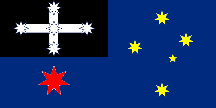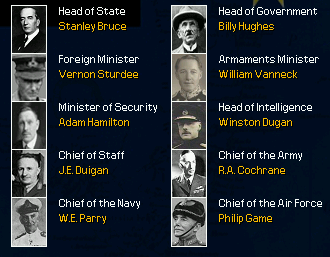Australasian Confederation
From Kaiserreich
| ||||
| Anthem God Save the King | ||||

| ||||
|
| ||||
| Official Language | English | |||
| Capital | Canberra | |||
| Head of State | George V, represented by Stanley Bruce | |||
| Head of Government | Billy Hughes | |||
| Establishment - Consolidation of Resources Act | December, 11 1924 | |||
| Government | Constitutional monarchy, dominion of the British Empire | |||
| Currency | Australasian Pound | |||
| Area | More than 8 millions of km² | |||
| Population | More than 8 millions | |||
The Australasian Confederation or Australasia is a country in Oceania. It consists of numerous islands in the Indian and Pacific Oceans. Neighbouring countries include the Dutch East Indies, the Portuguese colony of East Timor and the German colonial possessions in the Pacific Ocean (German New Guinea and Solomon islands).
Contents |
History
On January 1 1901 the six separate British self-governing colonies of New South Wales, Queensland, South Australia, Tasmania, Victoria and Western Australia formed a federation and became states of the Commonwealth of Australia. New Zealand chose not to take part in the Australian Federation and assumed complete self-government as the Dominion of New Zealand on September 26 1907 by proclamation of King Edward VII.
However, the defeat in the Weltkrieg was devastating for Britain and her loyal dominions. The British government found itself needing to keep the remnants of its empire intact, and they brought down an iron fist. The parliaments of Australia and New Zealand became essentially defunct as the elections scheduled for December 1922 in both Dominions were canceled under the Emergency Protocols act of 1922 and the two Dominions (together with British New Guinea and the British colony of the Fiji islands) were merged into Australasia under the Consolidation of Resources act of 1924. King George V appointed Stanley Bruce, who had proved to be a loyal supporter of Britain, as Governor-General of the newborn Australasian Confederation.
Politics
|
Governor-General: Stanley Bruce (born 15 April 1883)
Prime Minister: Billy Hughes (born 25 September 1862)
Minister for External Affairs: Vernon Sturdee (born 24 March 1890)
Minister for Trade and Customs: William Vanneck (born 3 January 1883)
Attorney-General: Adam Hamilton (born 20 August 1880)
Director of the Joint Intelligence Bureau: Winston Dugan (born 3 September 1876)
Minister for Defence: J. E. Duigan
Chief of the General Staff: Ralph Alexander Cochrane (born 24 February 1895)
Chief of Staff of the Australasian Commonwealth Naval Board: William Edward Parry (born 1893)
Chief of the Air Staff: Philip Game (born 30 March 1876)
Under the appointed position of Governor-General, Stanley Bruce has been able to keep Australasia stable and secure for many years; however lately there has been a growing unrest and a rise of racism and there are many calling for a new Australasian regime.
Military
Army
The Australasian Army is large and well-organized and consist of several infantry divisions and a good number of cavarly division, together with a few garrisons to defend strategic positions such as Port Moresby and the island of Tasmania. Despite not being equipped with advanced weapons, the Australasian army in sometimes looked with envy by the Canadian Army, for it is larger, better organized and better led as several of the more progressive British generals settled in Australasia. For the future, the are plans for the inclusion of a few Marine divisions in the Australasian Army.
Air Force
The Australasian government concentrated its military investments in the army and the navy and therefore the Royal Australasian Air Force has been neglected. At the moment there is only a division of tactical bombers, but there are plans for an expansion of the air force and the construction of several naval bombers.
Navy
The Royal Australasian Navy comprise several ships from the Weltkrieg's era and a good transport force to send the troops where they are most needed. However, a modernization and expansion of the navy is in program for the near future.
Foreign relations
Alliance (also known as the Entente) with Canada, National France, Delhi and the Caribbean Federation.
Friendly relations with United States of America, Italian Federation, Spain and Russia
Unfriendly relations with Germany, Union of Britain, Japan, Bengal and Netherlands.


